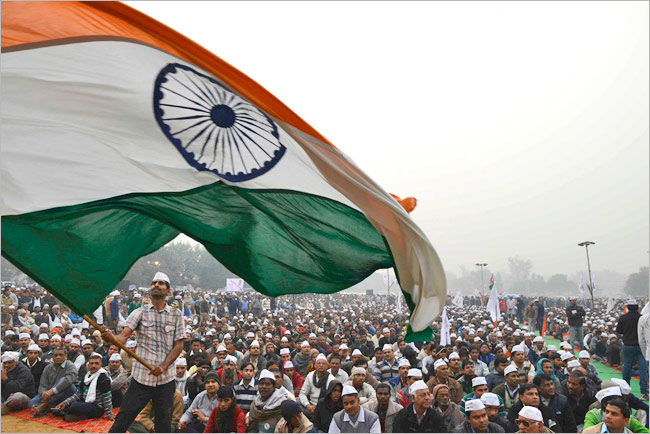Shimla: After its maiden resounding win in neighbouring Punjab in February, the Aam Aadmi Party (AAP) fast-tracked its political activities in poll-bound Himachal Pradesh.
But as the assembly elections in the BJP-ruled state draw closer, its momentum in the hill state, where it is yet to field a credible mass face, has been slowing down with the top leadership focusing on strengthening its vote bank in poll-bound Gujarat.
Politically, a bright spot for the AAP at this point of time is the Communist Party of India-Marxist (CPI-M) announcement to extend support to the party on the seats it is not contesting. The CPI-M has a lone legislator in the 68-member Himachal assembly.
Politically, a bright spot for the AAP at this point of time is the Communist Party of India-Marxist (CPI-M) announcement to extend support to the party on the seats it is not contesting. The CPI-M has a lone legislator in the 68-member Himachal assembly.
The BJP won 44 of the 68 assembly seats in 2017 with a vote share of 48.8 per cent, up from 38.47 per cent in 2012.
Its rival the Congress won 21 seats with a vote share of 41.7 per cent, down from 42.81 per cent in 2012.
In 2017, the CPI-M had fielded 14 candidates but could get only the Theog seat where Rakesh Singha had won with a slender margin of 1,983 votes. That was the party’s first win after 24 years. In the upcoming polls the party has fielded 11 candidates till date.
Taking the lead, the AAP, which is projecting itself as the third alternative in the well-entrenched bipolar system, announced its first list of candidates for four constituencies.
BJP rebel Rajan Sushant is the AAP’s Fatehpur assembly segment candidate, Umakant Dogra from Nagrota Bagwan, Manish Thakur from Paonta Sahib and Sudarshan Jaspa from Lahaul-Spiti, a reserved seat.
With a political career spanning four decades, largely with the saffron party, Sushant recently rejoined the AAP after quitting it six years ago. In 2020, he had floated his own outfit, Hamari Party Himachal Party. He has been a four-term legislator and one-time MP.
Manish, who joined the AAP in March, was the Youth Congress national secretary and its state president, while both Jaspa and Umakant are social workers.
Aiming to woo the electorate on the pattern of Punjab and Delhi, the AAP’s pre-poll 10 guarantees include employment to the six lakh youth, Rs 3,000 unemployment allowance, Rs 1,000 per month to women aged above 18, corruption-free governance and a Rs 10 lakh annual grant for every panchayat.
Fearing a dent in its vote share with the AAP raining freebies, BJP’s Chief Minister Jai Ram Thakur took to populist announcements of providing free electricity up to 125 units, up from the existing 60 units, and a 50 per cent concession in bus fare for women.
He justified the decisions by saying Himachal Pradesh is a power-surplus state and the concession for women is a step towards their empowerment.
Sensing a threat in a state that follows the two-party system with no space for a third one, the saffron party is trying to weaken the AAP’s base by inducing its top state leadership into the party fold.
In April, the AAP’s state president Anup Kesari, state women wing chief Mamta Thakur, state general secretary Satish Thakur and Una district chief Iqbal Singh were among those who joined the BJP.
Political insiders told IANS that the AAP is relying largely on dissidents from both the BJP and the Congress. Once the allocation of tickets by both the parties will start, those who are denied the party nomination will start changing loyalties.
Initially, thousands of supporters have come forward to work for or join the AAP, which was unusual in the past. ‘But the party is leaderless. It has to come with a Chief Ministerial face well in advance along with its prospective candidates,’ a political observer said.
Chief Minister Thakur, in whom the central leadership reposed faith by bringing a generational change in the state politics, believes the AAP is not an alternative as people have previously rejected a third front in the state.
‘Long ago an attempt was made to form a third political alternative. It failed despite the tallest state leader heading it,’ he told IANS in a recent interview.
A political observer believes that the AAP is posing more of a threat to the Opposition Congress than the ruling BJP.
‘In every poll, the victory gap in vote percentage traditionally remains four to six per cent in the state. If AAP manages to cut a two-three per cent vote share of a party, the damage seems more to the Opposition than the ruling party owing to the absence of Congress veteran late Virbhadra Singh. So the AAP’s maiden foray in the assembly polls makes the political landscape smoother for the BJP,’ added the observer.
The AAP made its debut in the state in 2014 by fielding candidates for all the four Lok Sabha seats.
The leaders, who joined the AAP then, were keen to contest the 2017 Assembly elections, but the AAP leadership decided not to enter the fray.
A seasoned journalist with over two decades of experience, Vishal writes on a wide range of subjects which include biodiversity, climate change and links between environment & development. He also covers politics and other developments in Punjab and Himachal Pradesh. He lives in Chandigarh & Shimla.




